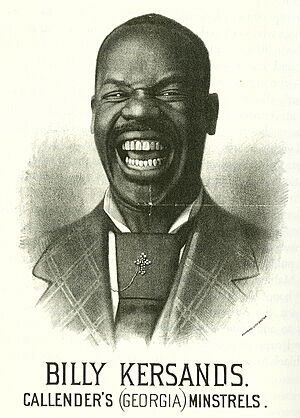Billy Kersands facts for kids
Billy Kersands (born around 1842 in Baton Rouge, Louisiana – died 1915 in Artesia, New Mexico) was a famous African-American comedian and dancer. He was one of the most popular black entertainers of his time. Kersands was best known for his performances in blackface minstrel shows.
Besides being a skilled acrobat, dancer, singer, and musician, Kersands was famous for his funny acts using his very large mouth. He could twist his mouth into funny shapes or even fit objects like billiard balls or saucers inside it! On stage, he often played a character who seemed a bit silly. Experts say Kersands was one of the first black entertainers who had to balance making people laugh with challenging or even using negative stereotypes.
Contents
Billy Kersands' Career
Kersands started performing with traveling minstrel groups in the early 1860s. As black minstrel shows became more popular, Kersands grew into a huge star. By 1882, he was earning about $80 a week, which was a lot of money back then. He even earned $250 a week during his tours in Europe!
He was very popular with both white and black audiences, especially in the Southern United States. One writer, Tom Fletcher, said that "In the South, a minstrel show without Billy Kersands is like a circus without elephants."
Working with Minstrel Troupes
During his career, Kersands performed with many major black minstrel groups. He was part of Sam Hague's Georgia Minstrels. Later, in 1872, Charles Callender bought the group and renamed it Callender's Georgia Minstrels. Kersands and other popular performers eventually left to start their own group, but it didn't do well. So, Kersands returned to Callender's group.
While with Callender's, Kersands often performed in funny military sketches. These acts helped him become well-known for his amazing drumming and acrobatic skills.
Starting His Own Show
In 1885, Kersands started his own minstrel group called Kersands' Minstrels. His group was famous for its great marching band. In 1886, they even led a Mardi Gras parade! Kersands was so proud of his band that he offered $1000 to any rival group that could outmarch them. He also continued to perform with other companies.
Later in his career, Kersands preferred to tour mainly in the South. When asked why he didn't move to the popular vaudeville shows, he said, "All of my money came from the people of the South, the white and the colored... I feel at home. I also make a good living with no worries."
How Billy Kersands Performed
Kersands' comedy acts often focused on his very large mouth. He would twist it into many different shapes. He used these mouth movements and funny noises during his songs. One person said that "The slightest curl of his lip or opening of that yawning chasm termed his mouth was of itself sufficient to convulse the audience." He could even fit several billiard balls or a cup and saucer into his mouth while still dancing or making the audience laugh loudly.
Stereotypes and His Audience
It's important to know that minstrel shows often used exaggerated and sometimes harmful racist stereotypes of black people. Kersands sometimes used these ideas in his acts, like playing a character who seemed slow or ignorant. He also sang songs that included these stereotypes. For example, his song "Old Aunt Jemima" later inspired the famous Aunt Jemima character for pancakes.
However, many African Americans still liked his performances. Kersands often added parts of African American folklore into his show. These parts would appeal to his black audience, even if white audiences didn't notice or understand them. For instance, "Old Aunt Jemima" often started in a church, which was a place white minstrel shows usually avoided. His songs sometimes included talking animals or stories about the weak winning against the strong.
Kersands' popularity was so great that many theater owners started to relax rules that limited black audience members to certain parts of the theater.
Dancing and Acrobatics
Even though Kersands weighed over 200 pounds, he was also a very talented dancer and acrobat. His special dance was called Essence of Old Virginia, or Virginia Essence. This dance later helped create the soft shoe style. He was also known for the buck-and-wing dance. His dance routines helped make these kinds of acts popular in later vaudeville shows and Hollywood movies.
His Final Years
Billy Kersands passed away in 1915 in Artesia, New Mexico. He was 73 years old and died shortly after a performance.


